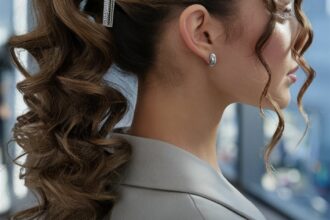Hair color can be an exciting form of self-expression, but sometimes change becomes necessary. Whether you’re moving on from a vibrant fantasy hue, correcting a DIY mistake, or just craving a clean slate, one of the first solutions that may come to mind is a hair color remover.
But what exactly happens when you put color remover on your hair? What results should you expect? And most importantly, how can you care for your strands after the process?
In this complete, expert-level guide, we’ll uncover the truth behind color removers—how they work, what they do to your hair chemically and visually, what potential risks they pose, and how to restore and maintain your hair health after removal.
Let’s decode the process, step by step.
Table of Contents
1. What Is a Hair Color Remover?
A hair color remover, sometimes called a color corrector or dye remover, is a chemical solution designed to remove oxidative artificial color from hair. These products are primarily used to strip out permanent and semi-permanent dyes, leaving the hair closer to its pre-dyed color.
However, contrary to common belief, color removers do not lighten your natural hair color. They only target the artificial color pigments that were introduced during dyeing. If your natural hair was lightened during the coloring process (via bleach or high-lift color), color remover won’t bring your natural color back.
2. How Do Hair Color Removers Work?
The science behind hair color removers lies in reduction chemistry. Most professional color removers are non-bleaching formulas that use a reducing agent—typically sodium hydrosulfite (also called hydrosulfite or dithionite)—to break down the color molecules.
Here’s how the process works:
- Hair dye works by oxidizing color molecules and locking them into the hair shaft.
- A color remover introduces a reducing agent that shrinks these dye molecules, making them small enough to be rinsed out of the hair.
- The artificial pigment is loosened and lifted out when you rinse, shampoo, and cleanse your hair thoroughly.
Important note: Color removers do not “erase” the dye from your hair like a magic wand—they reduce it and depend heavily on your rinsing process. Incomplete rinsing can allow the dye to re-oxidize and darken again
3. Color Remover vs. Bleach: What’s the Difference?
Let’s clear up a common misunderstanding: color remover and bleach are not the same.
| Feature | Color Remover | Bleach |
|---|---|---|
| Purpose | Removes artificial dye | Lightens natural and dyed hair |
| Active Ingredient | Reducing agents | Hydrogen peroxide & ammonia |
| Effect on Hair Health | Gentler, but can be drying | Highly damaging, especially on repeated use |
| Removes Natural Pigment? | No | Yes |
| Smell | Often sulfur-like, strong | Chemical but less sulfuric |
While both products are used for lightening or changing hair color, bleach permanently strips the melanin, while color removers only affect artificial pigment.
4. What Happens Immediately After You Use a Color Remover?
🔹 Color Lift:
Expect your hair to look significantly lighter. Depending on the dye and your hair history, results may vary from a soft copper or brassy blonde to a slightly yellow tone.
🔹 Hair Texture Changes:
Even though color removers are less aggressive than bleach, they can still leave your hair feeling dry, porous, or slightly rough. You might notice a loss of smoothness or elasticity.
🔹 Odor:
Most removers contain sulfur-based agents, which may produce a strong rotten egg-like smell during and after treatment. This typically fades after several washes.
🔹 Uneven Color:
If your hair has been dyed multiple times or in different shades, expect uneven lifting. Roots, ends, and mid-lengths may appear mismatched due to how hair absorbs color differently in each zone.
5. Common Unexpected Results
Hair color removal doesn’t always go as planned. You may experience:
6. Factors That Influence the Final Outcome
Not all hair will respond the same way. Here’s what influences the result:
✅ Number of Dye Applications:
Repeated color layers are harder to remove. The more times you’ve dyed over the same section, the more stubborn the pigment.
✅ Hair Porosity:
Highly porous hair may release color quickly but also absorb dye unevenly. Virgin or less porous hair may resist remover.
✅ Type of Dye Used:
Permanent dyes lift more easily with color removers than direct dyes (like fashion colors or vegetable-based semi-permanents). Direct dyes may need clarifying treatments or even bleach.
✅ Original Hair Color:
If your hair was bleached before coloring, your post-removal shade may reveal that bleached base—not your natural tone.
7. Is Your Hair Safe After Using a Color Remover?
Color removers are less damaging than bleach, but that doesn’t mean they’re risk-free. Here’s what may happen:
🔸 Dryness & Weakness:
The removal process lifts not only color but also some natural oils from your strands, causing dryness and fragility.
🔸 Porosity Increase:
The cuticle may become more porous, leading to less shine, more frizz, and faster color fade in future dyes.
🔸 Sensitivity:
Sensitive scalps may react to the ingredients with mild irritation, so a patch test is always advised.
8. Post-Treatment Hair Care: Do’s and Don’ts

✅ Do’s:
- Use a protein-rich deep conditioning mask immediately after rinsing.
- Apply hydrating oils (like argan, jojoba, or coconut oil) to restore moisture.
- Wait at least 7–10 days before applying new dye, especially if you’re going lighter.
- Use a sulfate-free shampoo and conditioner to avoid further stripping your hair.
- Incorporate bond-building treatments (like Olaplex or K18) to restore integrity.
❌ Don’ts:
- Don’t apply bleach or high-lift color right after removal.
- Avoid heat styling for a few days to allow your hair to recover.
- Don’t expect your natural color to return unless your hair was never lightened.
9. Recoloring After a Color Remover: When and How
🕒 When to Recolor:
Wait at least one week, and complete 2–3 deep conditioning treatments before dyeing again.
🎨 Choosing Your New Color:
Post-removal hair is more porous, meaning it grabs color faster. Choose a shade 1–2 levels lighter than your desired result to avoid overly dark results.
🧴 Prep Tips Before Recoloring:
- Clarify your hair 1–2 days before re-dyeing to remove buildup.
- Perform a strand test for the new color.
- Use a filler (if going darker) to avoid patchy results.
10. FAQs About Hair Color Removal
❓ Can a color remover damage my hair?
Yes, but typically less than bleach. Damage is mostly dryness, not structural breakdown.
❓ Will my hair return to its natural color?
Only if your natural color was never lightened or bleached. Otherwise, you’ll see a lighter base.
❓ Can I use color remover on henna-dyed hair?
No—most removers won’t work on henna or metallic dyes, and the interaction can be unpredictable.
❓ How many times can I use a color remover?
Once or twice is ideal. Repeated use can cause dryness and breakage. Always deep condition between uses.
11. Final Thoughts: Should You Try a Color Remover?
If you’re looking to remove unwanted artificial color and want a gentler alternative to bleach, a color remover can be a powerful tool—if used correctly.
It’s important to remember:
- The results will vary based on your hair history.
- You must follow instructions precisely.
- Aftercare is critical to maintaining healthy, vibrant hair.
By understanding the science, setting realistic expectations, and nurturing your hair after the process, you can safely reset your hair color journey without unnecessary damage.
12. The Ultimate Guide to Transitioning from Dyed Hair to Your Natural Color
Summary:
For those tired of the dyeing cycle or embracing their natural look, this article explores how to gracefully transition from colored hair to your natural shade. Covers various methods like growing out, blending techniques, color correction, toner use, and proper haircare during the transition. Includes emotional benefits, styling tips, and expert do’s and don’ts.
13.How to Repair Chemically Damaged Hair Like a Pro: Complete Restoration Plan
Summary:
Perfect for anyone suffering from over-processing, this comprehensive guide offers actionable steps to revive hair damaged by bleach, dye, straightening, or perms. Includes science-based treatment plans, product recommendations, routines, protein/moisture balance advice, and salon vs. home-care comparisons. Totally user-friendly and deeply researched.
.14 Semi-Permanent vs. Permanent Hair Color: Which One Is Right for You?
Summary:
This article breaks down the pros and cons of semi-permanent and permanent hair dye options. Covers how they work, the commitment level, damage potential, fade rate, best use cases, and who should choose what based on lifestyle, hair type, and goals. SEO-rich with expert-backed comparisons and practical guidance.
15.Why Your Hair Color Always Fades Too Fast—And How to Make It Last
Summary:
An in-depth guide revealing the real reasons behind rapid color fading. Includes hair porosity science, environmental damage, shampoo types, water temperature, styling habits, and more. Packed with preventative strategies, long-lasting color hacks, and products that preserve vibrancy without harm.





